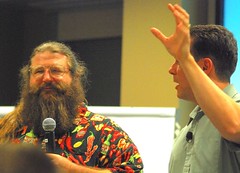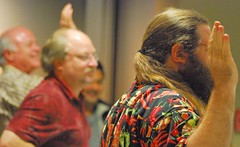|
|
privacy |
||
|
Hangout for experimental confirmation and demonstration of software, computing, and networking. The exercises don't always work out. The professor is a bumbler and the laboratory assistant is a skanky dufus.
Blog Feed Recent Items The nfoCentrale Blog Conclave nfoCentrale Associated Sites |
2007-10-06NWCPP: Herb Sutter - Things Your Programming Language Never Told YouLiving a short commute from Redmond, Washington, I was able to attend the Northwest C++ group's meeting with Herb Sutter on September 19. I was delighted to have my Herb Sutter books autographed. I follow Sutter's blog, so his name has high recognition for me, more than for his being Chair of the ISO committee on C++. Andrei Alexandrescu, co-author of C++ Coding Standards: 101 Rules, Guidelines, and Best Practices was also at the standing-room-only presentation. He signed my book as well. Not being a Dr. Dobb's regular, I didn't know much about Alexandrescu and I hope we'll see more of him as he completes his graduate studies. The talk centered on machine architectures and how that impacts the optimization of programs (by compilers) and the performance of the code that we write, performance that we may have little sense for. Sutter has announced the video and slide set for your viewing. This will completely shatter many ideas about how to write "optimum" programs and whether one should even try (although reducing algorithmic complexity (and decision cost) is almost always a good idea, as reinforced near the end of the talk:
Here's my skimpy collection of bullet points, but a review of the slides and an index to the now-available video would be superior:
Fortunately, the slides of the presentation have been made available and you can figure it out from there. [update 2007-10-08: Added the link to the video of Sutter's presentation and his recommendation about this particular topic. I also remember talking to someone near the door afterward and remarking that computer processors are like software now, not because of micro-programming but because of the scheduling and heuristics for pipelining and maintaining consistency. Now the compiler doesn't reorder your code (though it can help the processor that way), the processor reorders and interleaves your code to hide latency in concurrency. There was a recent blog post that reminded me of that. I'll find it again eventually.]
|
||

|
You are navigating Orcmid's Lair. |
template
created 2004-06-17-20:01 -0700 (pdt)
by orcmid |

